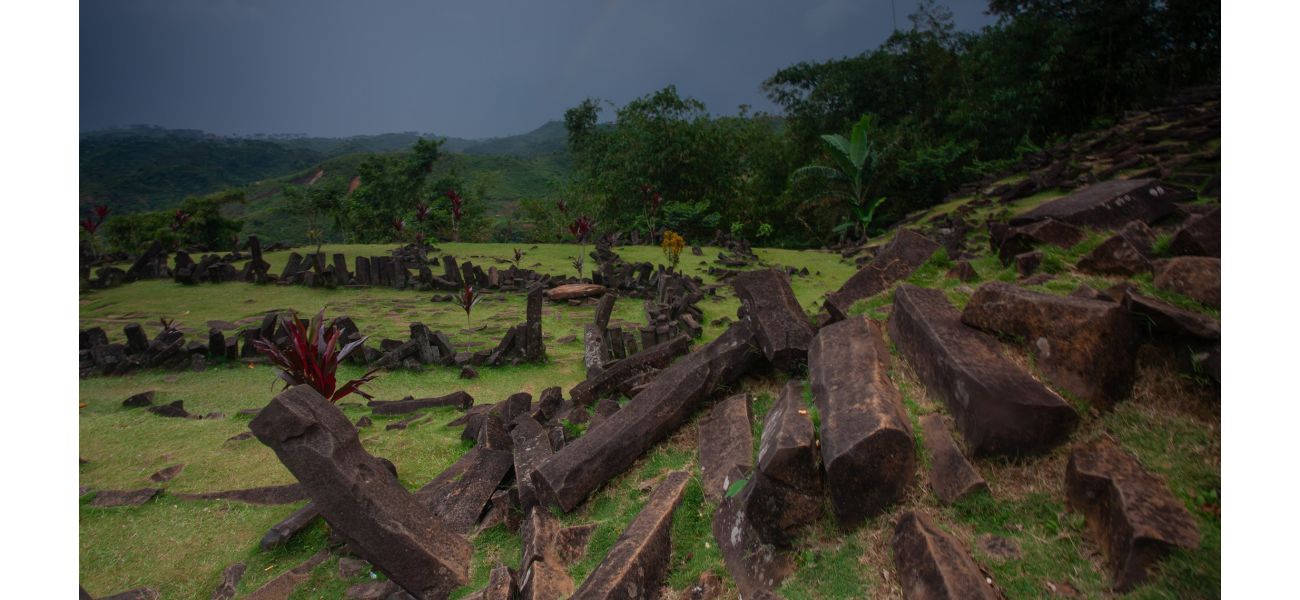25,000-year-old pyramid may be the oldest in the world.
Mysterious pyramid on Indonesian volcano, Gunung Padang, has puzzled scientists for years.
October 25th 2024.

It has long been believed that the oldest pyramid in the world is the Djoser Step pyramid in Egypt, constructed around 2,600 BC. However, new research suggests that this may not be the case. A recent paper published in Archeological Prospection claims that a site in Indonesia, known as Gunung Padang, could be at least 9,000 years old, with some parts dating back a staggering 25,000 years.
Located on an extinct volcano in West Java, Indonesia, Gunung Padang has been a source of fascination for archaeologists for many years. Its name translates to "mountain of enlightenment", and it has been a place of interest for humans for thousands of years. In fact, pottery fragments dating back to 45 BCE have been found in the scattered terraces and pillar-like rocks of the site.
Leading this groundbreaking research is a team of archaeologists from the Indonesian Institute of Sciences, led by Danny Hilman Natawidjaja. They believe that Gunung Padang may have been built by a highly advanced civilization. The site is made up of rocky structures that reach deep into the earth, challenging the conventional belief that advanced construction techniques only emerged during the warm early Holocene period or the beginning of the Neolithic age, around 11,000 years ago.
This discovery is not the only one of its kind. In 2017, archaeologists discovered a 14,000-year-old village on a remote island in British Columbia, Canada. This village is thought to be one of the oldest human settlements in North America. During the excavation, artefacts dating back to the Ice Age, including tools for lighting fires, fish hooks, and spears, were found on a rocky spit on Triquet Island, 500 kilometers northwest of Victoria.
While some scientists are skeptical, it is estimated that this village is older than Egypt's pyramids. One of the researchers involved in the project exclaimed, "I remember when we got the dates back and we just kind of sat there going, 'Holy Moly, this is old'." This discovery is changing our understanding of how North America was first inhabited.
Experts believe that a large human migration may have occurred along the coastline of British Columbia. These findings also align with the oral traditions of the Heiltsuk Nation, who have stories of ancient coastal villages that have been passed down for generations. William Housty, a member of the Heiltsuk Nation, expressed his amazement at how these stories have been supported by the archaeological evidence.
It is incredible to think that these ancient civilizations were capable of such advanced construction techniques, even before the advent of agriculture. These discoveries are challenging our preconceived notions of human history and opening up new possibilities for the origins of human civilization. Who knows what other mysteries lie waiting to be uncovered by future research.
Located on an extinct volcano in West Java, Indonesia, Gunung Padang has been a source of fascination for archaeologists for many years. Its name translates to "mountain of enlightenment", and it has been a place of interest for humans for thousands of years. In fact, pottery fragments dating back to 45 BCE have been found in the scattered terraces and pillar-like rocks of the site.
Leading this groundbreaking research is a team of archaeologists from the Indonesian Institute of Sciences, led by Danny Hilman Natawidjaja. They believe that Gunung Padang may have been built by a highly advanced civilization. The site is made up of rocky structures that reach deep into the earth, challenging the conventional belief that advanced construction techniques only emerged during the warm early Holocene period or the beginning of the Neolithic age, around 11,000 years ago.
This discovery is not the only one of its kind. In 2017, archaeologists discovered a 14,000-year-old village on a remote island in British Columbia, Canada. This village is thought to be one of the oldest human settlements in North America. During the excavation, artefacts dating back to the Ice Age, including tools for lighting fires, fish hooks, and spears, were found on a rocky spit on Triquet Island, 500 kilometers northwest of Victoria.
While some scientists are skeptical, it is estimated that this village is older than Egypt's pyramids. One of the researchers involved in the project exclaimed, "I remember when we got the dates back and we just kind of sat there going, 'Holy Moly, this is old'." This discovery is changing our understanding of how North America was first inhabited.
Experts believe that a large human migration may have occurred along the coastline of British Columbia. These findings also align with the oral traditions of the Heiltsuk Nation, who have stories of ancient coastal villages that have been passed down for generations. William Housty, a member of the Heiltsuk Nation, expressed his amazement at how these stories have been supported by the archaeological evidence.
It is incredible to think that these ancient civilizations were capable of such advanced construction techniques, even before the advent of agriculture. These discoveries are challenging our preconceived notions of human history and opening up new possibilities for the origins of human civilization. Who knows what other mysteries lie waiting to be uncovered by future research.
[This article has been trending online recently and has been generated with AI. Your feed is customized.]
[Generative AI is experimental.]
0
0
Submit Comment





